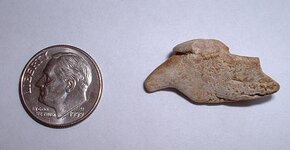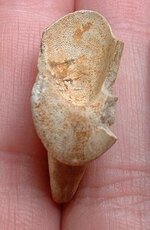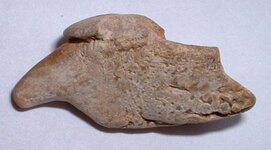- Joined
- Nov 19, 2002
- Messages
- 3,031
The fossil we are looking at here is one-half of a beak of a cephalopod called Belosepia (a.k.a Belosaepia). Belosepia is probably best described as a form of primitive cuttlefish that lived in subtropical waters. Precisely how it is related to the modern Sepia seems to have been, and still is, the subject of debate; nonetheless researchers do seem to agree that it is of the stem lineage that led to the cuttlefish.
Unlike the modern cuttlefish, the cuttlebone of this animal had a pimpled surface covered in tubercles and lacked the cross-strutted structure of today’s Sepia. It is a quite well known fossil and various species of Belosepia have been described from Eocene formations worldwide, notably the London Clay in the south of England, the Paris basin in France and some formations in Africa as well as North America.
The cuttlefish, being one of most advanced forms of cephalopod, were probably one of the most recent groups to arise, almost certainly after the end-Cretaceous mass-extinction. The genus Belosepia is known from 58-33 million years ago but this particular beak dates from the Middle Eocene Epoch (43-46 mya). It was found in the Stone City Formation at Cook Mountain in Texas. This is located in the south-eastern area of Texas on the Brazos River, the bluff is approximately 105 miles northwest of Houston and is a very fossiliferous site, composed of various layers of clay, marl and sand. It is known for exceptional preservation of invertebrate animals, particularly shelled animals.
Unlike the modern cuttlefish, the cuttlebone of this animal had a pimpled surface covered in tubercles and lacked the cross-strutted structure of today’s Sepia. It is a quite well known fossil and various species of Belosepia have been described from Eocene formations worldwide, notably the London Clay in the south of England, the Paris basin in France and some formations in Africa as well as North America.
The cuttlefish, being one of most advanced forms of cephalopod, were probably one of the most recent groups to arise, almost certainly after the end-Cretaceous mass-extinction. The genus Belosepia is known from 58-33 million years ago but this particular beak dates from the Middle Eocene Epoch (43-46 mya). It was found in the Stone City Formation at Cook Mountain in Texas. This is located in the south-eastern area of Texas on the Brazos River, the bluff is approximately 105 miles northwest of Houston and is a very fossiliferous site, composed of various layers of clay, marl and sand. It is known for exceptional preservation of invertebrate animals, particularly shelled animals.




